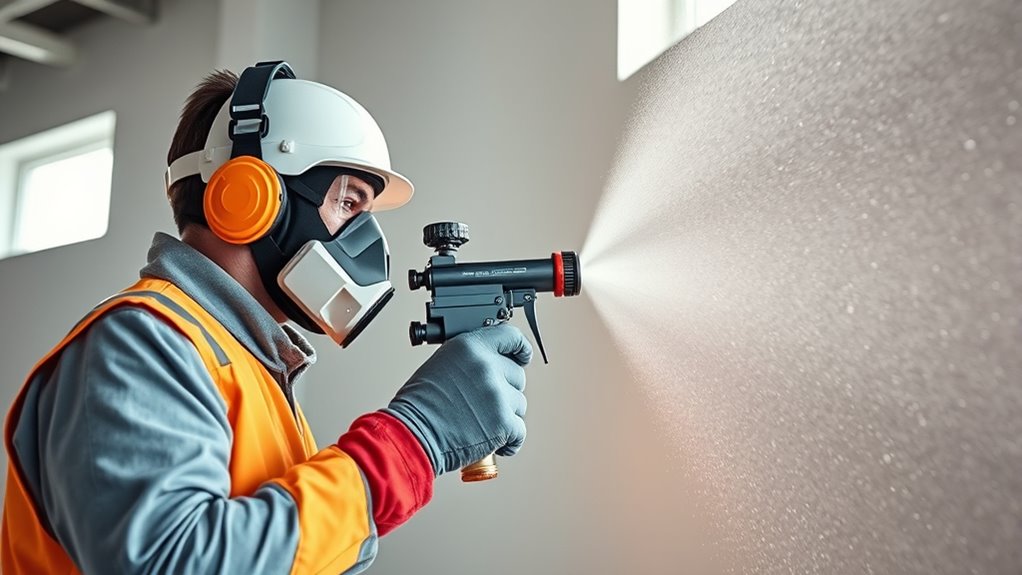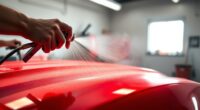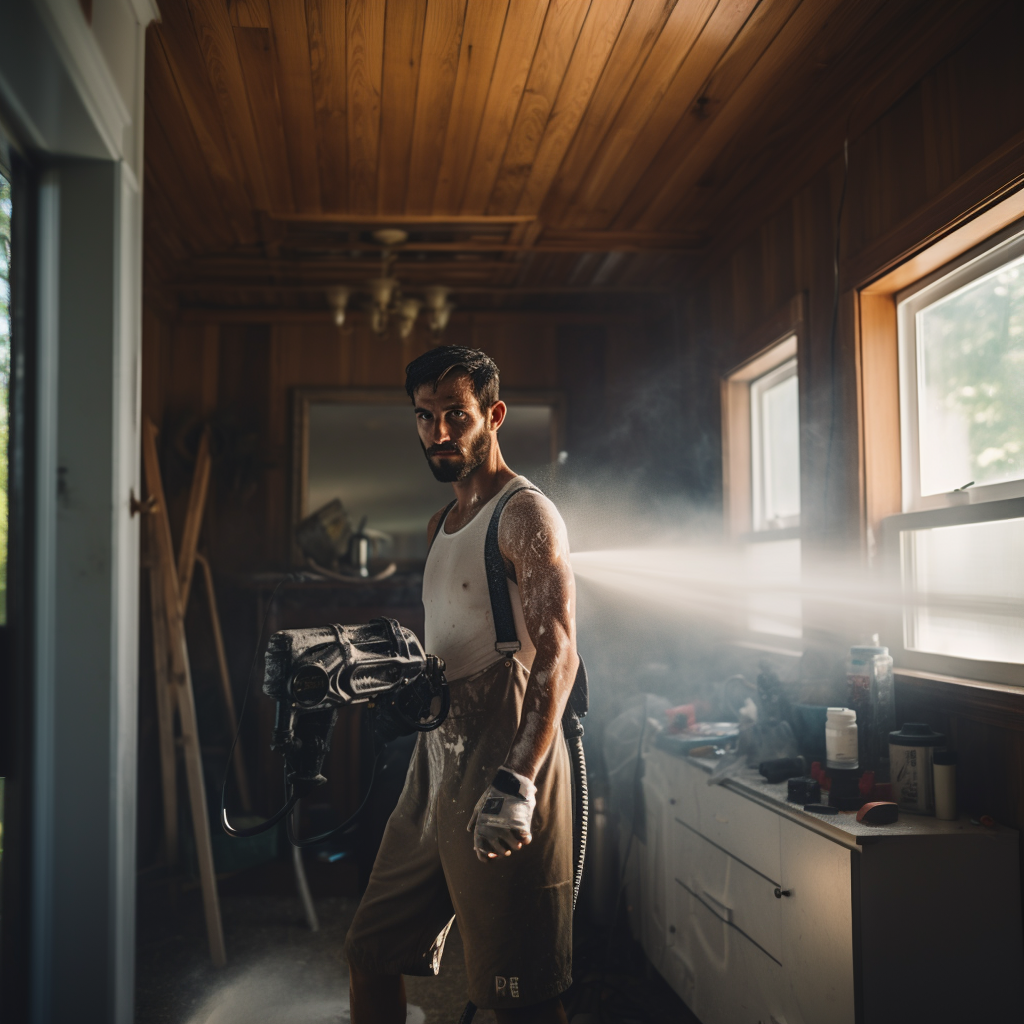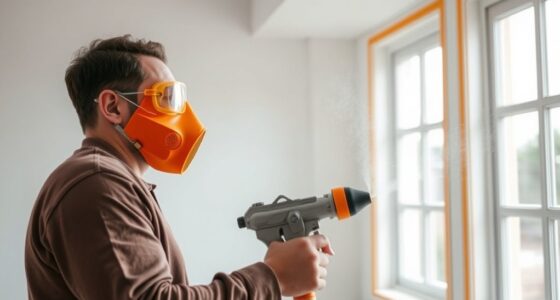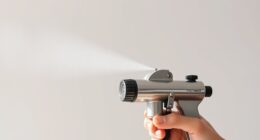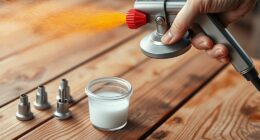To boost your spray painting speed and quality, choose high-performance, adjustable equipment suited for your project size. Prep surfaces thoroughly by cleaning, sanding, and priming to guarantee smooth application with minimal overspray. Master consistent spray techniques, maintain steady movements, and keep a proper distance from surfaces. Organize your workflow efficiently, protect surrounding areas, and perform final touch-ups carefully. Keep your tools clean and equipment calibrated for ideal results—learn more tips to maximize your efficiency and finish with perfection.
Key Takeaways
- Use high-quality, adjustable spray guns and maintain them regularly to ensure consistent application and prevent delays caused by equipment issues.
- Organize tools and materials efficiently, planning workflow to minimize movement and overlap for faster completion.
- Properly prepare surfaces with thorough cleaning, sanding, and priming to reduce rework and ensure smooth, even coats.
- Practice steady, consistent spraying techniques at optimal distances and angles to improve coverage speed and reduce overspray.
- Incorporate modern automation tools and digital workflows to enhance precision, reduce manual errors, and streamline project timelines.
Selecting the Right Equipment for Fast, Quality Results
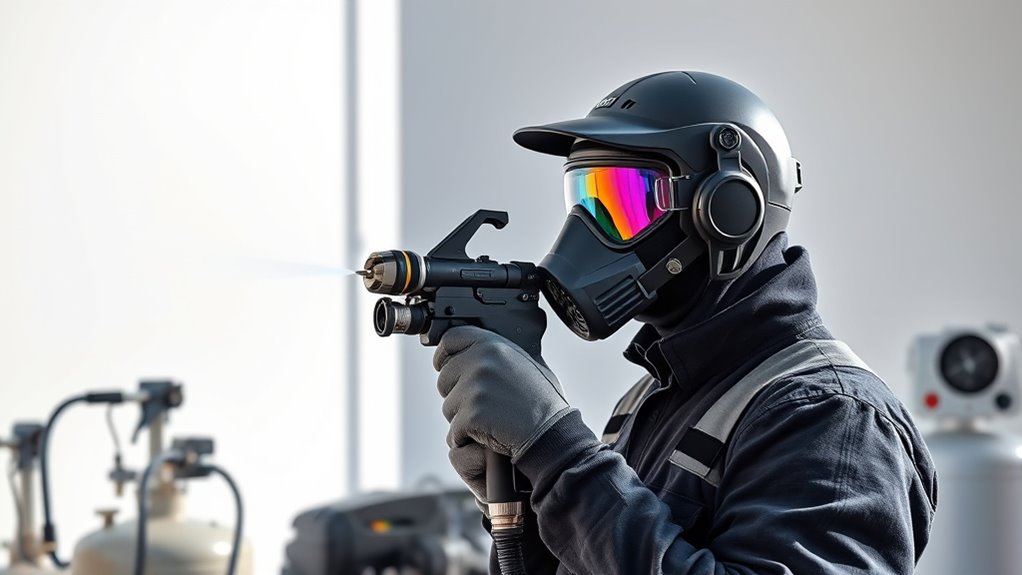
Choosing the right spray painting equipment is essential for achieving fast, high-quality results. You want tools that deliver consistent spray patterns, helping you match colors accurately without wasting time. A good spray gun with adjustable settings allows you to control the flow and pattern, ensuring precise color matching every time. Proper maintenance and cleaning of your sprayer is also crucial for optimal performance and to prevent clogs that can lead to uneven application. Regularly inspecting and replacing filtration components like filters can significantly extend your equipment’s lifespan and maintain spray quality. Additionally, selecting high-performance tools designed for durability and precision can greatly enhance your workflow and finish quality. Using the correct technique and positioning during application helps ensure a smooth, even coat and reduces material waste. Safety precautions are also vital; always wear proper masks, goggles, and protective clothing to prevent inhaling fumes or getting overspray on your skin. Selecting equipment suited for your project size and surface type boosts efficiency and reduces rework. Investing in high-quality equipment may cost more upfront but pays off with better finish, faster application, and safer working conditions. Ultimately, the right tools set the foundation for professional results while maintaining safety standards.
Preparing Surfaces for Smooth Application and Reduced Overspray

Before you start spray painting, make sure to clean and sand the surface thoroughly to guarantee a smooth finish. Mask off surrounding areas to prevent overspray from reaching unwanted spots. Applying the right primer will help the paint adhere better and reduce the chances of drips or uneven coverage. Additionally, considering vehicle tuning modifications can optimize the surface’s compatibility with various paint types for a more durable finish. Recognizing angel number signs related to love can also boost your confidence in choosing the right timing for your projects. Being aware of digital literacy programs for seniors can inspire you to incorporate educational tools that enhance your team’s skills and ensure a more professional application process. Understanding special occasions can also help in scheduling projects around community events or personal celebrations for better coordination. Exploring sound healing science can also provide insights into the importance of balance and precision during your work to achieve optimal results.
Clean and Sand Thoroughly
To achieve a smooth, professional spray paint finish, you need to start by thoroughly cleaning and sanding the surface. Proper surface preparation guarantees better adhesion and reduces overspray. Begin by removing dust, dirt, and grease with a tack cloth or damp rag—this step is vital for dust removal. Sand the surface evenly to create a slight texture, which helps the paint adhere better. Use appropriate grit sandpaper based on the surface material. Additionally, understanding the importance of Gold IRA Rollovers can help diversify your investment portfolio and provide long-term security. Incorporating modern automation technologies can further improve your efficiency and consistency during the painting process. Ensuring your spray equipment is clean and functioning properly can prevent clogged nozzles that cause uneven spray patterns and overspray. Regular maintenance of your tools and equipment is essential for consistent results and to avoid equipment failures during critical application stages. Wipe down the surface with a clean cloth to eliminate sanding dust. Inspect the surface under good lighting to check for imperfections. Final dust removal using compressed air or a cloth guarantees a dust-free surface.
Mask Off Surroundings
Masking off surrounding areas is essential to achieve a clean, professional finish and minimize overspray. Start by laying down drop cloths over floors, furniture, and any nearby surfaces to protect them from paint splatters. Use painter’s tape to carefully cover edges, trims, and fixtures, ensuring a sharp, crisp line. When the painting is complete, don’t rush tape removal; wait until the paint is fully dry to prevent smudging or peeling. Carefully peel back the tape at a 45-degree angle to maintain clean lines. Proper masking saves you time on cleanup and helps deliver a polished, professional look. Taking these steps ensures your work remains precise, reducing rework and achieving maximum results with less effort.
Use Proper Primer
Applying the right primer creates a smooth, even surface that helps paint adhere better and reduces overspray. To achieve ideal surface adhesion and primer compatibility, follow these tips: 1. Choose a primer suited for the surface material—whether wood, drywall, or metal. 2. Clean surfaces thoroughly to remove dirt, grease, and loose debris before priming. 3. Test primer compatibility on a small area to ensure proper adhesion. 4. Apply a uniform, thin coat to prevent drips and ensure better coverage. Regularly inspecting air purifier filters during prep work can help maintain a dust-free environment, ensuring a cleaner, more efficient painting process. Using the correct primer not only improves surface adhesion but also minimizes the need for multiple coats. This leads to a cleaner job with fewer touch-ups, saving you time and material. Proper priming sets the foundation for a flawless finish and efficient spray application.
Mastering Proper Spray Techniques for Consistent Coats
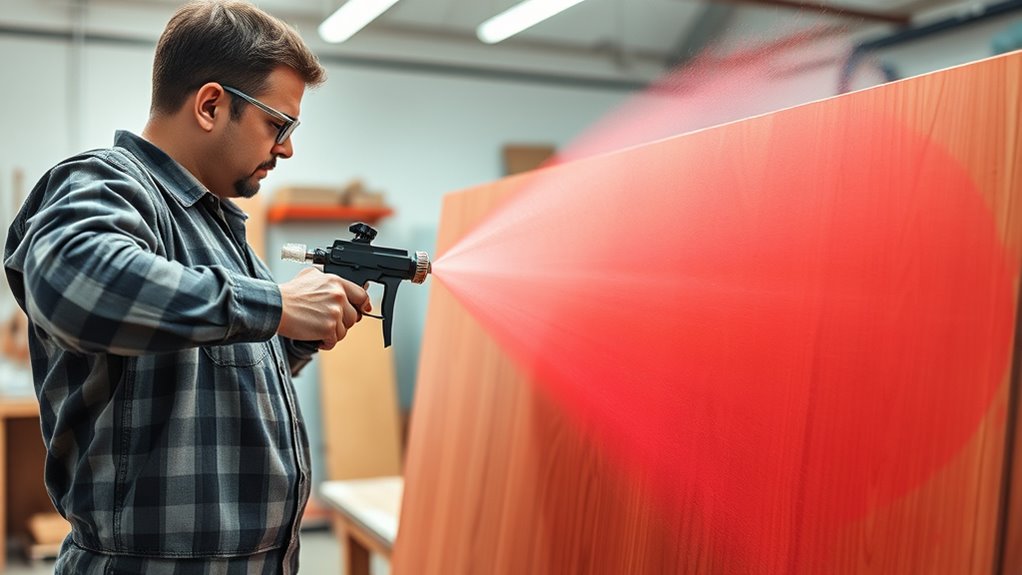
Mastering proper spray techniques is essential for achieving consistent coats and a professional finish. Start by controlling your spray angle; keep it at about 90 degrees to the surface for even coverage, adjusting as needed for textured or detailed areas. Practice smooth, steady movements to avoid runs and uneven layers. Incorporate brush techniques when shifting between spray passes or touching up edges to maintain uniformity. Keep your hand steady and maintain a consistent distance from the surface, usually around 6-12 inches. Avoid flicking or jerking the spray gun, which can cause overspray or uneven layers. Monitoring power consumption of your equipment can help manage energy use during long projects. Additionally, understanding cleaning and maintenance routines ensures your sprayer remains in optimal condition for consistent performance. Developing a good technique takes time and patience, but it ultimately leads to a flawless finish. With practice, you’ll develop a feel for the right spray angle and motion, resulting in smooth, consistent coats that look flawless and save you time on touch-ups. Incorporating proper ventilation strategies can also improve application quality and safety.
Optimizing Your Workflow to Save Time and Minimize Waste
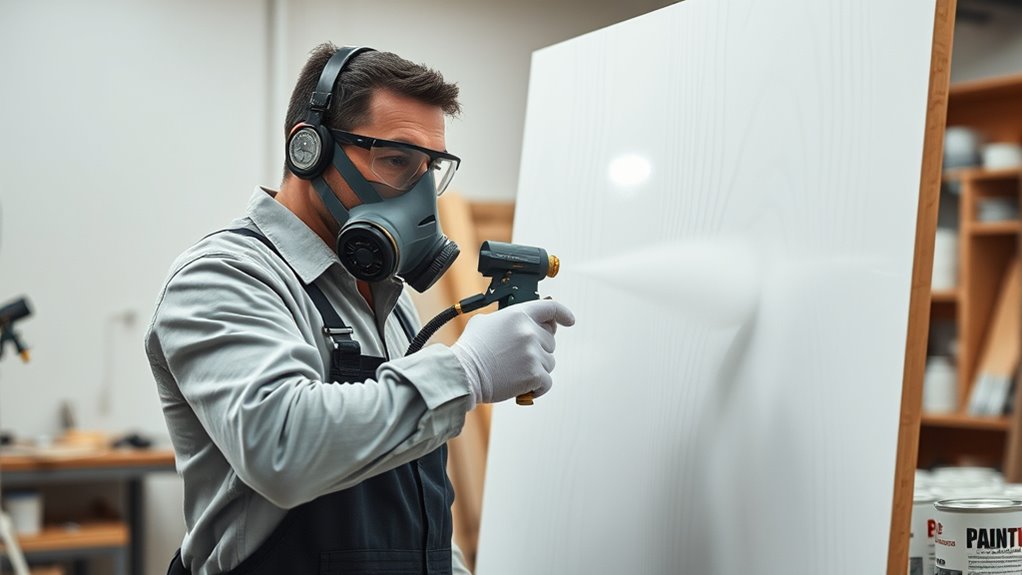
To save time and reduce waste, start by streamlining your equipment setup so everything is ready to go. Planning your application sequence helps avoid unnecessary movements and overlaps. When you organize these steps efficiently, your workflow becomes smoother and more cost-effective. Additionally, understanding your personality traits can improve communication and teamwork on the job site. Keeping your work area clean and organized also contributes to a more efficient workflow, minimizing delays and accidents. Incorporating storage and handling practices that prevent contamination or spoilage can further enhance your operational efficiency by ensuring compliance and building trust with clients. Implementing security features in your equipment and processes can also help protect sensitive project data and maintain a professional standard.
Streamline Equipment Setup
Streamlining your equipment setup begins with careful planning to guarantee everything is organized and ready before you start painting. Start by inspecting your tools for proper calibration to ensure a consistent finish. Use effective storage solutions to keep brushes, masks, and accessories accessible and protected. To maximize your setup:
- Arrange tools in the order you’ll use them to minimize movement.
- Calibrate spray guns for ideal spray patterns and material flow.
- Prepare and test equipment beforehand to catch issues early.
- Designate a dedicated workspace with clear storage for each item.
- Consider the importance of contrast ratio in your setup to ensure the projected images meet your quality standards.
Plan Application Sequence
Planning your application sequence carefully can substantially boost efficiency and reduce waste. Begin by organizing your project so you tackle similar surfaces in one pass, minimizing color mismatches and touch-ups. Use consistent brush techniques for edges and corners before switching to spray, ensuring clean lines and even coverage. Prioritize the order of colors to match drying times and avoid rework, especially when color matching is critical. Always plan your workflow to reduce unnecessary movement, working from top to bottom and left to right. This approach minimizes overspray and touch-ups, saving time. Clear sequencing helps you avoid cross-contamination and ensures accurate color matching. By thinking ahead about your application order, you’ll streamline your process, improve quality, and cut down on waste.
Tips for Managing Paint and Equipment During the Job
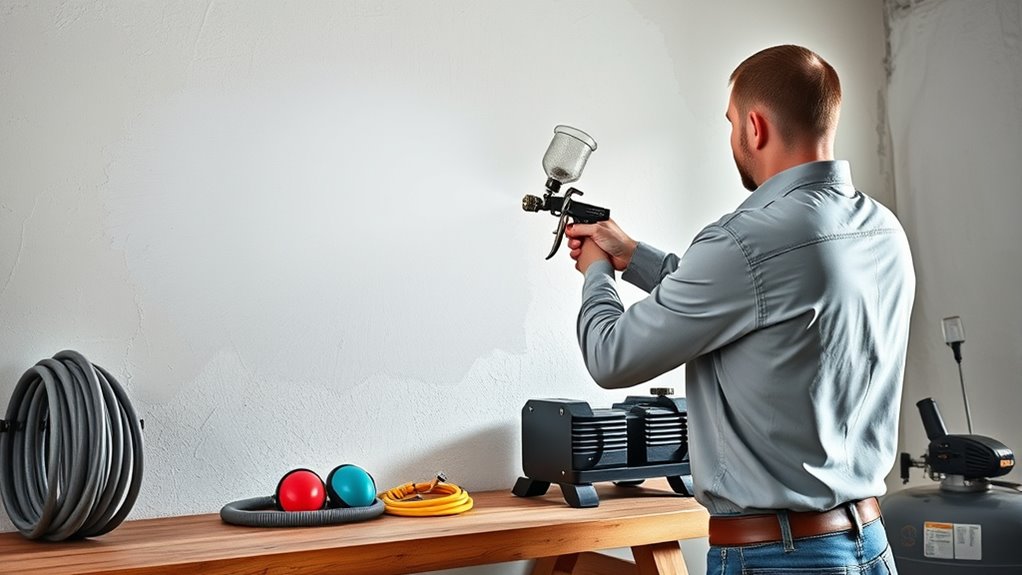
Managing your paint and equipment effectively can make or break a spray painting job. Proper organization ensures smooth progress and quality results. First, always follow safety protocols—wear protective gear and handle paint carefully to prevent accidents. Second, keep your paint well-mixed to maintain consistency; periodically stir or remix as needed. Third, monitor your equipment’s pressure and spray settings to avoid drips or uneven coverage. Fourth, store leftover paint in labeled, sealed containers to prevent contamination and ensure easy access for touch-ups. Regularly clean your spray gun and tools to maintain peak performance. Keeping your paint and equipment managed efficiently reduces delays, saves time, and promotes a professional finish. Stay diligent, and your job will run smoothly from start to finish.
Final Checks and Touch-Ups to Ensure a Flawless Finish

Before wrapping up a spray painting project, it’s vital to perform thorough final checks and touch-ups to guarantee a flawless finish. Start with a final inspection, examining the entire surface for any drips, uneven spots, or missed areas. Use good lighting to spot imperfections you might overlook in shadows. Apply touch-up techniques carefully, using a small brush or spray to blend repairs seamlessly into the surrounding paint. Pay attention to edges and corners, ensuring consistent coverage. Remove any dust or debris that may have settled on the surface, and consider a light sanding if needed before reapplying touch-up paint. These final steps help you catch mistakes early and ensure your work looks professional, durable, and polished.
Frequently Asked Questions
How Do I Troubleshoot Common Spray Gun Malfunctions Quickly?
When troubleshooting spray gun malfunctions, start by inspecting spray gun maintenance to make certain all parts are clean and properly assembled. Check for clogs or dried paint that can cause inconsistent spray patterns. Adjust the fluid, air, and fan controls to troubleshoot spray patterns. Regularly cleaning and maintaining your spray gun helps prevent issues, making quick troubleshooting easier. Always keep spare parts handy for rapid fixes and consistent, professional results.
What Are the Best Storage Practices for Leftover Paint and Equipment?
When storing leftover paint and equipment, you should focus on proper paint disposal and using the right storage containers. Seal paint tightly in original or airtight containers to prevent drying out. Label everything clearly for easy identification. Store paints in a cool, dry place away from heat sources. Clean your equipment thoroughly to extend its life. Proper storage helps you stay organized and ready for your next project, reducing waste and cleanup time.
How Can I Prevent Paint Clogging During Extended Spray Sessions?
Imagine your spray gun as a finely tuned orchestra, each part playing its role smoothly. To prevent paint clogging during extended sessions, you should regularly use a paint strainer to catch debris and keep the flow steady. Additionally, frequent nozzle cleaning guarantees your spray pattern remains flawless. These simple steps keep the rhythm going, preventing interruptions and ensuring your finish stays flawless from start to finish.
What Safety Precautions Should I Follow When Spraying in Tight Spaces?
When spraying in tight spaces, you should prioritize ventilation concerns to prevent inhaling fumes and guarantee proper airflow. Always wear appropriate personal protective equipment, including masks, goggles, and gloves, to safeguard against paint splatters and fumes. Keep windows and doors open if possible, and use fans to improve air circulation. Regularly check your PPE to maintain safety, and avoid prolonged exposure to fumes in confined areas.
How Do Weather Conditions Affect Spray Painting Speed and Quality?
Weather’s impact on spray painting is like the changing tide—temperature control is your anchor. When it’s too hot, paint dries too quickly, risking uneven finishes; too cold, and it won’t dry properly, causing drips and runs. Humidity can turn your smooth spray into a misty blur. Pay attention to these conditions, adjusting your pace and technique accordingly, to guarantee your work remains flawless, no matter the weather’s mood swings.
Conclusion
By applying these tips, you’re building a well-oiled machine that delivers quality with speed. Think of your spray painting skills as a finely tuned engine—every step, from prep to finish, keeps it running smoothly. When you stay organized and precise, you’ll turn each project into a masterpiece, faster and more efficient than ever. Keep refining your technique, and watch your reputation and results accelerate like a well-driven racecar.
Franz came aboard the Paint Sprayer Zone team with a background in both journalism and home renovation. His articulate writing style, combined with a passion for DIY projects, makes him an invaluable asset. Franz has a knack for breaking down technical jargon into easy-to-understand content, ensuring that even the most novice of readers can grasp the complexities of paint sprayers.
